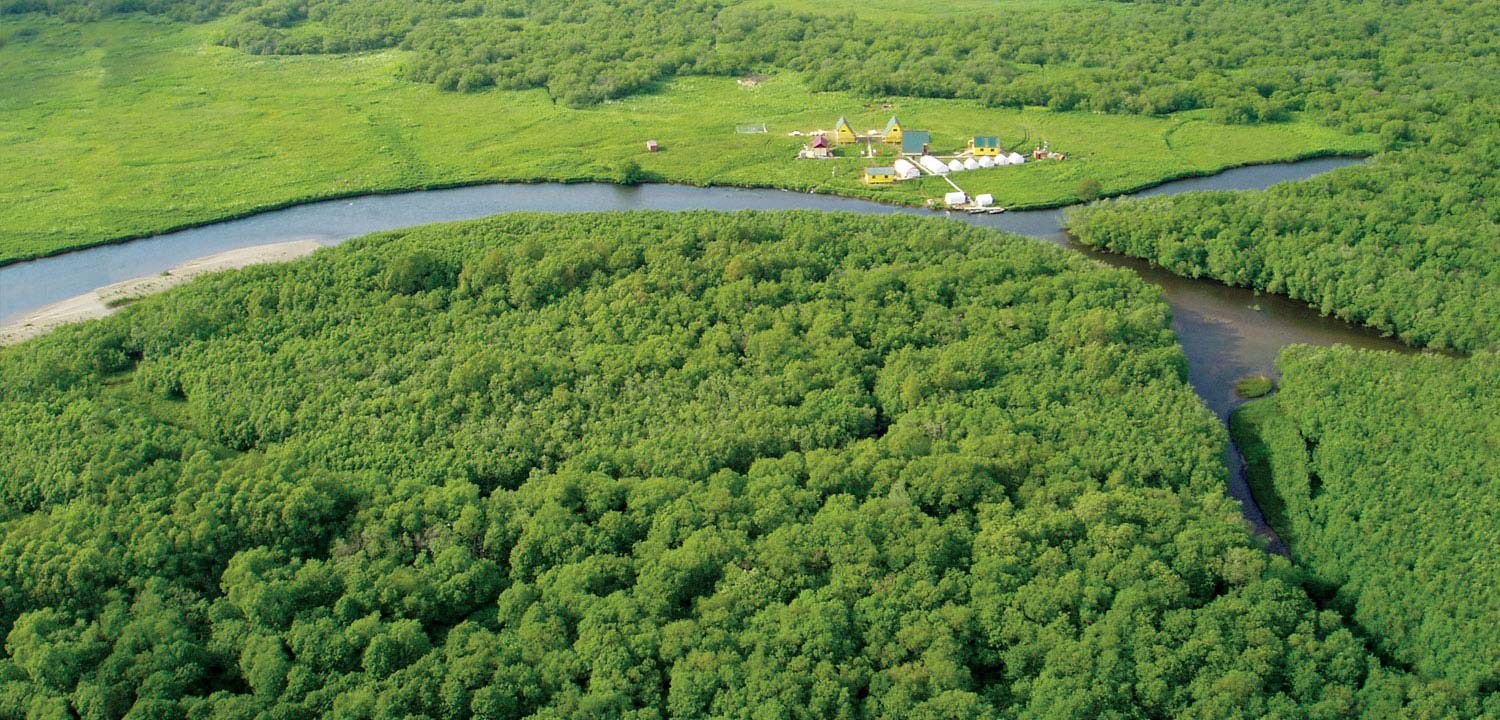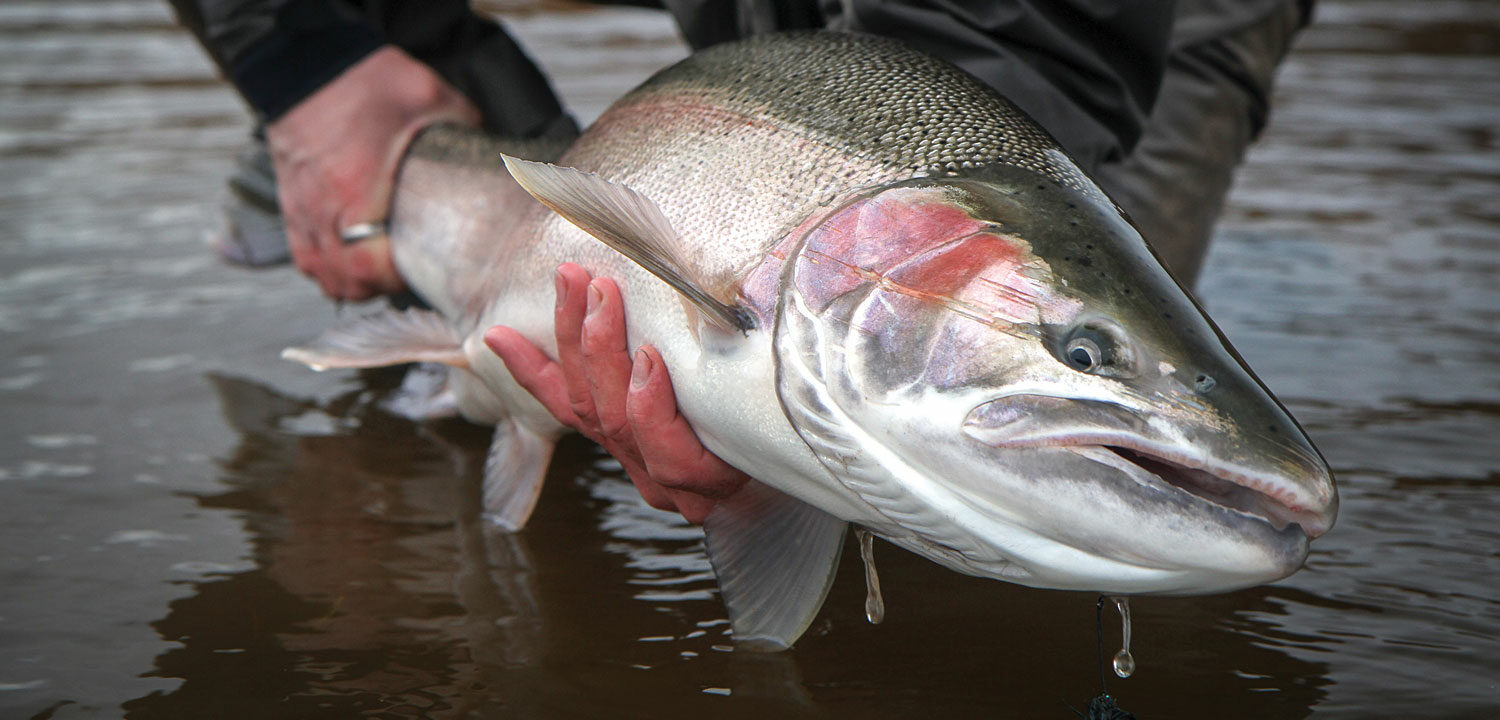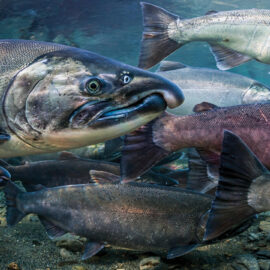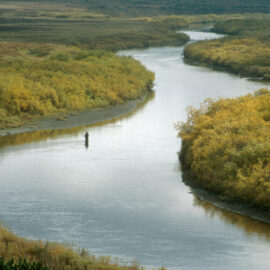Groundbreaking twenty-year joint Russian-American scientific project results in a wealth of information on the genetic diversity, population structure, and health of Kamchatka’s steelhead and trout.
From 1994-2002, the Wild Salmon Center guided scientific expeditions in Kamchatka as part of the Kamchatka Steelhead Project, the groundbreaking twenty-year joint Russian-American scientific project studying steelhead and trout. Collaborating with local and international groups, the Wild Salmon Center established a reputation as a leader with unmatched dedication, experience, and a deep interest in the long-term sustainability of the region. These scientific expeditions resulted in a wealth of new information on the genetic diversity, population structure, and health of Kamchatka’s steelhead and trout. Many of these findings have been published in the Russian and American scientific literature.
The Kamchatka Steelhead Project was developed jointly by the Ichthyology Department of Moscow State University (Russia) and the Wild Salmon Center (USA) to study and conserve steelhead, a species listed in the Red Book of Russia. In the first five years of work (1994-1998), participants in the joint program conducted expeditions on eight rivers in western Kamchatka collected a wide variety of scientific materials and data.
While the guided expeditions are no longer part of the Wild Salmon Center’s work on the Kamchatka Peninsula, the Kamchatka teelhead Project continues as a scientific partnership between WSC, the Ichthyology Department of Moscow State University, and the University of Montana’s Flathead Lake Biological Station.

Abbreviated Bibliography
From the Wild Salmon Center and Moscow State University. All articles published in Voprosy Ikhtiologii are available in the translated version, Journal of Ichthyology, widely available in the United States and Canada by inter-library loan (ILL).
Articles from Doklady Akademii Nauk – Biological Sciences are available by ILL. Voprosy Ikhtiologii abstracts in English from 1996 to 2003 are available from Voprosy Ikhtiologii and Doklady Akademii Nauk.
Some articles indicated have abstracts available online from the Wild Salmon Center or Voprosy Ikhtiologii while others generally have sufficient citation information for locating a copy at a university library or via intra-library loan(ILL).
Peer-Reviewed Articles
- Kuzishchin, K.V., Savvaitova, K.A., Gruzdeva M.A. 1999. Struktura cheshui kak kriterii differentsiatsii lokal’nykh populiatsii mikizhi Parasalmo mykiss iz rek zapadnoi Kamchatki i Severnoi Ameriki [Scale structure as criteria for the determination of local stocks of mikizha Parasalmo mykiss from western Kamchatkan and North American rivers] Voprosy Ikhtiologii [Journal of Ichthyology] 39(6):809-818.
- Kuzishchin, K.V. and Savvaitova, K.A. 1998. Struktura cheshui mikizhi iz rek Severo-Zapadnoi Kamchatki i Sandy River (Alaska) [The Structure of steelhead scales from the rivers of Northwest Kamchatka and from the Sandy River of Alaska]. Voprosy ikhtiologii [Journal of Ichthyology] (in publication).The structure of scales is analyzed (number of annular rings, width of growth zones) in the river and marine years of life of the intrapopulation groups (typically anadromous, coastal, ‘half pounders’, freshwater river) and local stocks of Kamchatkan and American steelhead. The differences between neighboring populations in Kamchatka are not large. The population of the Sandy River differs from the Kamchatkan ones by the structure of the scale in the river period of life (more and wider annuli).
- Kuzishchin, K.V., Pavlov, D.S., Savvaitova, K.A., Gruzdeva, M.A. and Pustovit, O.P. 2001. Downstream Migration of Juvenile Diadromous Kamchatka Trout Parasalmo mykiss in the Western Kamchatka Rivers. Voprosy ikhtiologii [Journal of Ichthyology] 41(3) 227-238.
- Savvaitova, K.A., Mina, M.V., Maksimov, V.A. 1975. Evolutionary Aspects of the Reproductive Ecology of Trout of the Genus Salmo in Kamchatka. Voprosy Ikhtiologii [Journal of Ichthyology] 15(1): 21-31.
- Kuzishchin, K.V. and Savvaitova, K.A. 1996. Osteologicheskiye osobennosti tikhookeanskikh forelei (Salmo) Kamchatki v sviazi s opredeleniem ikh taksonomicheskogo statusa. [Osteological Peculiarities of Pacific Trouts
(Genus Salmo) of Kamchatka in Connection with the Determination of their Taxonomic Status] Voprosy ikhtiologii [Journal of Ichthyology] 36(4): 288-306. - Mednikov, B.M., Shubina, Ye. A, Melnikova, M.N., Savvaitova, K.A. 1998. Problema rodovogo statusa tikhookeanskikh lososei i forelei. Genosistematicheskii analiz [The Problem of the Generic Status of Pacific Salmons and Trouts. A Genosystematic Analysis]. Voprosy ikhtiologii [Journal of Ichthyology] (in publication). Atlantic and Pacific salmons and trouts were studied by the method of electrophoretic analysis of nuclear DNA (taxonoprint). The DNA patterns of the species studied are divided into four groups: 1. Salmo salar; 2. Salmo trutta and closely related species; 3. Pacific trouts (including Kamchatkan forms); 4. Pacific salmons (O. masu, O. keta, O. gorbuscha, O. nerka, O. tshawytscha, and O. kisutsch). These groups correspond to their generic ranking. The merging of Parasalmo and Oncorhynchus into one genus Oncorhynchus is not confirmed at the genetic level and contradicts the international rules of zoological nomenclature.
- Pavlov, D.S. and Savvaitova, K.A. 1996. Sovremennye problemy izucheniia i sokhraneniia vida Krasnoi knigi Rossii – kamchatskoi mikizhi [Current Problems of Study and Conservation of the Kamchatkan mikizha, a Species Listed in the Red Book of Russia] Voprosy ikhtiologii [Journal of Ichthyology] 36(8): 578-583.
- Pavlov, S.D. and Kuzishchin, K.V. 1999. Morfobiologicheskie i geneticheskie osobennosti mikizhi Parasalmo mykiss iz reki Voyampolki (zapadnaya Kamchatka) [Morphobiological and genetic pecularities of mikizha Parasalmo mykiss from Voyampolka River] Voprosy Ikhtiologii [Journal of Ichthyology] 39(6):748-760.
- Pavlov, D.S., Savvaitova, K.A. and Kuzishchin, K.V. 1999. K probleme formirovaniia epigeneticheskikh variatsii zhiznennoi strategii u vida Krasnoiu knigi Rossii – kamchatskoi mikizhi Parasalmo mykiss (Salmonidae, Salmoniformes) [Regarding the problem of epigenetic variations of life-history strategy in the Kamchatkan Parasalmo (O.) mykiss, the species from Russian Red Data book] Doklady Akademii Nauk [Reports of the Russian Academy of Sciences – Biological Sciences] 367(5):709-713. (Russian)
- Proebstel, D.S., Savvaitova, K.A., Kuzishchin, K.V. 1997. Native trout of Kamchatka: a glimpse into the past of North America // Wild Trout VI. Montana St. Univ. Bozeman. pp. 77-85.
- Reshetnikov, Yu.S., Bogutskaya, N.G., Vasileva, E.D, Dorofeeva, Ye.A. Naseka, A.M., Popova, O.A., Savvaitova, K.A., Sidelava, V.G., and Sokolov, L.I. 1997. Spisok ryboobraznykh i ryb presnykh vod Rossii [List of the freshwater fishes of Russia] Voprosy ikhtiologii [Journal of Ichthyology] 37(6): 723-771.Gives a full list of 349 species of fishes living in the continental waters of Russia. Gives the names, the taxonomic changes, and additions (including data on the newly discovered trout in Kamchatka), defines the ranges of the species more
precisely. - Savvaitova, K.A., Kuzishchin, K.V. and Maximov, S.V. 1999. Kamchatka steelhead: Population trends and life history variations, in Sustainable Fisheries Management: Pacific Salmon (Knudsen, E.E., ed.) Lewis Publishers, New York 1999: 195-206.
- Savvaitova, K.A., Kuzishchin, K.V., Pavlov, D.S. 1999. Struktura lokal’nykh populiatsii mikizhi Parasalmo mykiss iz rek severo-zapadnoi Kamchatki i Severnoi Ameriki [The population structure of mikizha Parasalmo mykiss from Rivers of Northwest Kamchatka and North America] Voprosy Ikhtiologii [Journal of Ichthyology] 39(7): 504-516.
- Pavlov, D.S., Savvaitova, K.A., Kuzichshin, K.V. 2001. Theoretical aspects of the present-day distribution and forming of life history strategies in mikizha, Parasalmo mykiss (Salmonidae, Salmoniformes). Doklady Akademii Nauk [Reports of the Russian Academy of Sciences – Biological Sciences] Vol. 379: 344-347.At our period of time the range of mikizha in Asia is limited in Kamchatka, while throughout Kamchatkan waterbodies there is a strong difference in the ratio of phenotypes with different life history strategy. The most probable factors, determining occurrence and distribution of typically anadromous life history strategy pattern on Kamchatka can be considered the next ones: appearance of tundra rivers of tundra tributaries; appearance of deep pools of 2-5 m depth, that not freezing to the bottom during the winter to provide wintering of large non-feeding mature fish; appearance of the spawning ground, that fits for the spawning of large fish. The distribution of resident life history strategy is caused by the next reasons: appearance of the tundra rivers or tundra tributaries; appearance of non-freezing sections of the river with the spring waters, coming into the river bed, for wintering and feeding; appearance of the rivers with high gradient with transparent water, where fish is feeding in summer time; appearance of enough food and energetic resources in the river, for maturation not only males but females also.
- Pavlov, D.S., Savvaitova, K.A., Kuzichshin, K.V. 2000. Dwarf Males and Reproductive Tactics in the Mikizha Parasalmo mykiss Walbaum (Salmonidae, Salmoniformes) from the Kamchatka Peninsula. Doklady Akademii Nauk [Reports of the Russian Academy of Sciences – Biological Sciences] Vol. 373: 382-385.
- Savvaitova, K.A., Kuzishchin, K.V., Proebstel, D. 1998. Riady form forelei Zapadnoi Kamchatki. K probleme feneticheskogo raznobraziia gruppy [A Series of Forms of the Trout of Genus Salmo in Western Kamchatka. On the problem of the phenetic diversity of the group] Voprosy ikhtiologii [Journal of Ichthyology] 38(5): 366-373.
- Savvaitova, K.A. and Kuzishchin, K.V. 1998. Tendentsiia v izmenenii morfometricheskikh pokazatelei prokhodnoi formy Salmo mykiss iz rek severo-zapadnoi Kamchatki [Tendencies toward Change in the Morphometric Features of Diadromous mikizha Salmo mykiss from the Rivers of Northwest Kamchatka]. Voprosy ikhtiologii [Journal of Ichthyology] 38(3) 238- (in publication).
- Savvaitova, K.A. and Soverel, P. 1998. Discovered: Bering sea steelhead // International Journal of Salmon Conservation 1(1):2-3.
- Savvaitova, K.A. and Kuzishchin, K.V. 1998. Struktura populiatsii mikizhi iz rek Kamchatki i Severnoi Ameriki [The Population Structure of mikizha from the rivers of Kamchatka and North America] Voprosy ikhtiologii [Journal of Ichthyology] (in publication).
- Savvaitova, K.A., Kuzishchin, K.V., Maximov, S.V., and Pavlov, S.D. 1997. Struktura populiatsii kamchatskoi mikizhi v reki Utkholok (zapadnaya Kamchatka) [Population structure of mikizha, Salmo mykiss, in the Utkholok River (western Kamchatka)]. Voprosy ikhtiologii [Journal of Ichthyology]: 37(3) 216-225.
- Savvaitova, K.A., Kuzichshin, K.V., Maximov, S.V., Novikov, G.G. 1995. O raznoobrazii tikhookeanskikh forelei (rod Salmo) Kamchatki [On the diversity of Pacific trout (genus Salmo) in Kamchatka]. Voprosy Ikhtiologii [Journal of Ichthyology] 35(5):565-571.In 1994 an unusual trout was caught by anglers in the Tigil River basin. These specimens differed in a number of diagnostic characters from anadromous and freshwater forms of S. mykiss, inhabiting neighboring rivers. The trout from the Tigil River has several characters similar to those of S. clarki.
- Soverel, P., Savvaitova, K.A., Kuzishchin, K.V., Maximov, S.V., and Pavlov, S.D. 1997. The Kamchatka steelhead project: a unique approach to understanding and conserving steelhead and trout of Kamchatkan peninsula, Russia // Wild Trout VI. Montana St. Univ. Bozeman. P. 39-44.Describes the 1996 WSC-MGU expedition on Kamchatka. The Kamchatka steelhead project expedition demonstrates a combination of scientific study of endangered species and protection of the unique resource by the elimination of poaching during the field expedition.
- Stanford, J.A., Gayeski, N., Pavlov, D.S., Savvaitova, K.A. and Kuzishchin, K.V. 2002. Biophysical Complexity of the Krutogorova River (Kamchatka, Russia). Verh. Internat. Verein. Limnol. 28(3):1354-1361.The first examination of the biophysical complexity (geomorphology, benthic ecology, riparian structure) of a West
Kamchatka steelhead river. - Pavlov, S.D., Kuzichsin, K.V. 1999. Morphobiological and Genetic Features of Kamchatka Steelhead Parasalmo mykiss from the Voyampolka River (Western Kamchatka). Voprosy Ikhtiologii [Journal of Ichthyology] 39(9): 713-725.
- Williams, R.N., Powell, M.S., Pavlov, S.D., and Proebstel, D.S. Forthcoming. Molecular Genetic Variation among rainbow trout Oncorhynchus mykiss Walbaum (Salmonidae, Salmoniformes) from the Kamchatka Peninsula. Submitted to Journal of Fish Biology.
- Savvaitova, K.S. The Population Structure of Salmo mykiss in Kamchatka. 1975. Voprosy Ikhtiologii [Journal of Ichthyology] 15(6): 984-997.
- Kuzichshin, K.V., Pavlov, S.D., Gruzdeva, M.A., Pavlov, D.S., Maksimov, S.V., Savvaitova, K.S. 2002 Spawning Population and Reproductive Ecology of the Freshwater Kamchatka Steelhead Parasalmo mykiss in the Basin of the Zhupanova River (East Kamchatka). Voprosy Ikhtiologii [Journal of Ichthyology] 42(8): 601-614.
- Savvaitova, K.S., Tutukov, M.A., Kuzichshin, K.V., Pavlov, D.S. 2002 Changes in the Population Structure of Mikizha Parasalmo mykiss from the Utkholok River, Kamchatka, during the Fluctuation in Its Abundance.
Voprosy Ikhtiologii [Journal of Ichthyology] 42(3): 238-242. - Kuzischin, K.V., Pustovit, O.P., Pavlov, D.S., Savvaitova K.A. 2002 Morphobiological Traits of Downstream-Migrating Juveniles of Parasalmo mykiss from Some Rivers of Western Kamchatka in Relation to Smolting. Voprosy Ikhtiologii [Journal of Ichthyology] 42(9): 720-732.
Scientific Reports
Written for the Wild Salmon Center, Moscow State University, and the Ministry of Environment of the Russian Federation.
- The Kamchatka Steelhead Project: Studies toward the preservation of a species in the Red Book of
Russia), 1994 Science Report. (1995) 35 pp. - The Kamchatka Steelhead Project, 1995 Science Report (1996), 41 pp.
- The Kamchatka Steelhead Project, 1996 Science Report(1997), 43 pp.
- The Kamchatka Steelhead Project, 1997 Science Report (1998) 80 pp.
- The Kamchatka Steelhead Project Five-Year Report, 1994-1998 (1999). (See below).
- The Kamchatka Steelhead Project, 1999 Science Report (2000) 108 pp. (Russian only).
- The Kamchatka Steelhead Project, 2000 Science Report (2001) 108 pp. (Russian only).
- The Kamchatka Steelhead Project, 2001 Science Report (2002) 87 pp. (Russian only).
- The Kamchatka Steelhead Project, 2002 Science Report (2002) 93 pp. (Russian only).
Papers Presented
- Pavlov, D.S., Savvaitova, K.A., and K.V. Kuzishchin. 1999. Epigeneticheskie variatsii zhiznennoi strategii mikizhi v rekakh zapadnoi Kamchatki i strategiia sokhraneniia vida Krasnoi knigi [Epigenetic variation of life history strategy of mikizha in western Kamchatkan rivers and strategy for conservation of Red data book species] // Proceedings of conference “The problems of protection and rational using of natural resources of Kamchatka.” Petropavlovsk-Kamchatsky, June 10-12, 1999: 81. (Russian only)
- Savvaitova, K.A., Kuzishchin, K.V. 1997. The “series of forms” of Pacific trouts.
To the question of the origin of the group // Proceedings of the 1st Congress of Ichthyologists of Russia. Astrakhan’, September 1997: 51. (Russian only) - Savvaitova K.A., Kuzishchin K.V., Gruzdeva M.A., Pavlov D.S., Maksimov S.V., Pavlov S.D. 1999. Struktura lokal’nykh populiatsii mikizhi v rekakh zapadnoi Kamchatki i problemy ikh okhrany [The structure of local populations of mikizha in Western Kamchatkan Rivers and problems of their conservation] // Proceedings of conference “The problems of protection and rational use of natural resources of Kamchatka.” Petropavlovsk-Kamchatsky, June 10-12, 1999: 87-88. Russian only.
- Savvaitova, K.A., Kuzishchin, K.V., Maksimov, S.V., Pavlov, S.D. 1997. Changes in population structure in anadromous steelhead from North-West Kamchatkan Rivers // Proceedings of the 1st Congress of Ichthyologists of Russia. Astrakhan, September 1997: 51-52. (Russian only)
Steelhead Project Report
Part I. Overview and Methodology
- OverviewThe 20-year (1994-2014) scientific program to study and conserve the present condition of Kamchatkan steelhead (mikizha), a species listed in the Red Book of Russia. In the first five years of this program, we have analyzed and assessed the nature of the problem, the current level of knowledge, the extent of research, the goals and tasks, the starting assumptions, the methods of proceeding, and the expected results. An annotated list of the publications produced by the project in this time period is attached to the report.
- MethodologyThe limitations imposed on fieldwork by the Red Book status of the species are discussed, as are the principles on which the selection of study sites is based, the non-destructive methods of collecting most of the materials, and the scope of the materials collected. The basic method of collection is by fly fishing on a catch-and-release basis; this method does minimal harm to populations of the species. The possibilities for collecting materials for analyses that require killing the specimen fish are severely restricted by the small number of permits issued for this purpose. In a number of instances, the collected material is not sufficiently representative, and must be combined with similar material from other years. This drawback, however, is somewhat compensated for by the complex nature of the investigations and the simultaneous study of the characteristics of numerous local populations of mikizha on a comparative basis.
Part II. Scientific Results
- Epigenetic variations of the life strategies of mikizha in the rivers of western Kamchatka.Five variations of life strategies, or adaptive norms, of Kamchatkan Parasalmo (Oncorhynchus) mykiss are identified for the first time on the basis of scale morphology. They belong to two basic types: a resident (riverine) type, and a migratory type, which consists of typically-anadromous, anadromous (including the “half-pounder” stage), estuary, and river-estuary life strategies. The migratory type varies greatly, depending on the length of migration routes and the length of time spent at sea prior to sexual maturation. The diversity of phenotypic variations with different life strategies is the expression of individual changeability. The ratio and frequency of phenotypic variations with different life strategies are not uniform throughout the range, and are determined by specific living conditions in different rivers. A key is proposed to determine the scale types and the life strategy variations with which they correspond.
- Scale morphology as criteria for differentiation of local stocks of mikizha in western Kamchatka.The scale structure (number of circuli, width of annual growth zones) in the river and marine years of life of mikizha phenotypes with different life strategies in different rivers of Kamchatka and North America is examined. Small differences in the scale structure of mikizha from different local stock are found and, in principle, it is possible to differentiate local stocks by this method.
- The structure of local populations of mikizha in western Kamchatkan rivers.The correlation of phenotypes with different life strategies in local populations is studied. These include the dates of entering the river and of spawning; the age composition; the duration of the periods spent in the river and at sea; the age of first sexual maturation; repeat spawning; body length and weight; and growth rates of mikizha in six rivers of western Kamchatka and the Sandy River of Alaska in comparison with other populations in North America. In western Kamchatka, the preponderant form is anadromous mikizha of the stream maturing type; in North America the preponderant populations are of the ocean maturing type, which enter the river with mature gonads. In contrast to the Kamchatkan populations, the American populations are characterized by extended periods of migration and spawning. The indices that characterize local population structures in Kamchatka and in North America vary between comparable limits, and are determined by specific living conditions.
- Morphometric description of mikizha in various West Kamchatkan rivers, and the tendency of morphometric features to change over time.Analysis of multiple measurements shows that there is a relatively small degree of divergence in external morphological features among typically anadromous mikizha in the western Kamchatkan rivers we studied. Despite a certain observable correlation between the latitude of the habitat and geographic variability in the number of vertebrae and the branching fin rays, variability in other features is a mosaic that is probably largely determined by specific living conditions.Changes in morphometric features of Kamchatkan steelhead from three northwestern Kamchatkan rivers that were subject to various degrees of human impact were studied with respect to chronology (1971-72 and 1994-96). In all of the rivers, the size of the fish, the average size of most of the features, the indices of change and the nature of the distribution curves did not change noticeably. The number of vertebrae, however, diminished, and the changes are not only in the center of the range of values, but are also at the limits of variation for this feature. The greatest changes were observed for steelhead from the Utkholok River, a population whose numbers diminished and whose population structure changed. In the aggregate of features, there were tendencies to change in the external appearance of the fish, and the Utkholok River population of mikizha occupied a more distant position in relation to the populations of the Snatolveyem and Kvachina rivers.
- Phenetic diversity of freshwater trout in KamchatkaUntil recently, the only form of freshwater trout known to exist in Kamchatkan water bodies was mikizha, P. (O.) mykiss mykiss, analogous to the American P. (O.) mykiss irideus. In the basin of the Tigil River we discovered for the first time trout with features of the American redband trout P. (O.) mykiss, as well as with features of P. (O.) clarki clarki (coastal cutthroat trout), P. (O.) clarki lewisi (westslope cutthroat trout), or P. (O.) mykiss aguabonita (Californian golden trout). The Kamchatkan forms, however, are not fully identical to any of the American subspecies. There are transitions between all of them–individuals with different
combinations of unclearly expressed features–which are difficult to assign to one or another form. On the whole, the Tigil River basin trout are a series of forms, the extreme variants of which differ greatly from each other in the number and distribution of black spots on head and body, in the brightness and dimensions of the orange spot on the throat (the cutthroat mark), in the rainbow stripe along the lateral line, and in the
number and development of the basibranchial teeth. The cutthroat trouts, P. (O.) clarki and the redband trouts of the species P. (O.) mykiss, which until recently were known only in North America, are the most primitive representatives of the group. It is not improbable that the primitive Kamchatkan forms diverged from each other to a lesser degree than did the American representatives and that northeast Asia was the place where the evolution of the group began. - Osteological description of anadromous and freshwater forms of Kamchatkan representatives of genus Parasalmo in connection with the problem of determining their taxonomic status.We studied the osteological features of anadromous Kamchatkan mikizha P. (O.) mykiss from the Kvachina River and of freshwater trout from the Tigil River basin, which are similar to redband trout P. (O.) mykiss or cutthroat trout P. (O.) clarki. Both quantitative and qualitative differences were found in the structure of the skulls and of individual bones. Only a few features, however, have taxonomic significance. Differences were found in the form of the vomer, in the number of rows of teeth on its handle, and in the numbers of teeth themselves, on the basis of which both of the studied forms can be distinguished without error. Anadromous and freshwater mikizha are well distinguished by the position of the hyomandibular bone in relation to the flat surface of the bone and the form of the canals on the dorsal surface of the ethmoid section of the chondrocranium.
- Isozyme variability and the genetic divergence of Pacific trouts (genus Parasalmo) of western Kamchatka.Preliminary data show that the species P. (O.) mykiss is represented in the Kamchatkan part of its range by
populations, each of which is to some degree genetically unique and has alleles which are specific to Kamchatka. By the level of genetic diversity and polymorphic protein loci it is possible to separate eastern Kamchatkan mikizha (from the basin of the largest river in Kamchatka) and western Kamchatkan populations. Separate polymorphic loci can serve as geographic markers of populations. The complex population structure of mikizha in some of the rivers we studied could theoretically be connected to the genetic determination of the ecoforms. This makes it exceedingly important to conduct intrapopulation genetic analysis of the local stocks of Kamchatkan mikizha. - The problem of the genetic status of Pacific salmons and trouts. A systematic genetic analysis.Atlantic salmons and Pacific salmons and trouts were studied by electrophoretic analysis of nuclear DNA, using fine-splintering restriction enzymes (the taxonoprint method). The DNA patterns of the studied species divide into four groups. These groups correspond to genetic rank.
Part III. Preservation Approaches
Approaches to preserving the biodiversity of fishes in Kamchatka. The role of rare and vanishing
species of fishes listed in the Red Book in the preservation of biodiversity.
Approaches to preserving the biodiversity of fishes in Kamchatka are proposed. Using the example of Kamchatkan steelhead, the role of rare and vanishing species of fish in preserving biodiversity is discussed. For the first time in Russia, a model is being developed for the conservation of species diversity on the basis of a combination of ecosystem and population approaches. A new model for studying a Red Book species without harming it has been tested and approved. In the framework of a scientific expedition, its sponsors–international
angler-conservationists–participate in the collection of scientific materials to assess the biodiversity of a Red Book species, working on the principle of “catch and release.” Their work can be viewed as the highest form of ecotourism.
The five-year report is set forth in 238 pages of typed text, with 82 tables and 53 figures.



